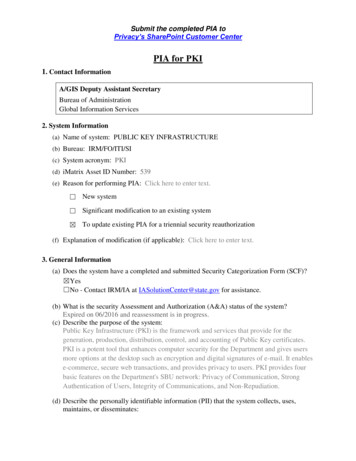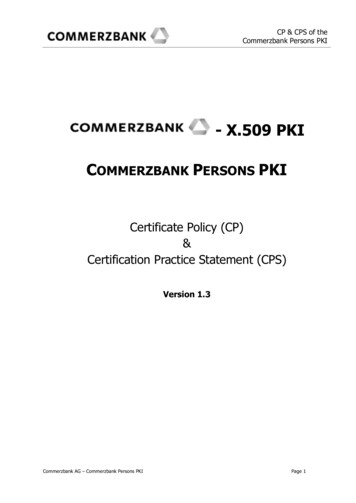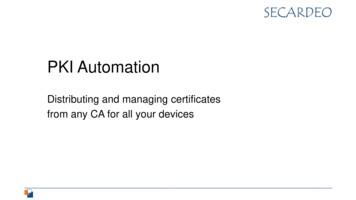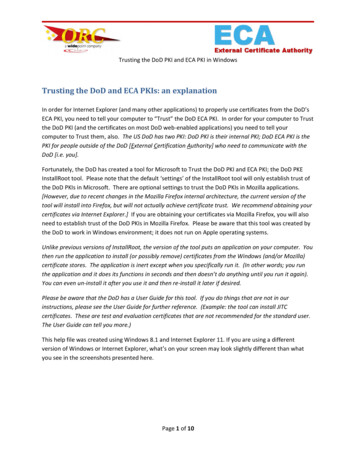
Transcription
Submit the completed PIA toPrivacy’s SharePoint Customer CenterPIA for PKI1. Contact InformationA/GIS Deputy Assistant SecretaryBureau of AdministrationGlobal Information Services2. System Information(a) Name of system: PUBLIC KEY INFRASTRUCTURE(b) Bureau: IRM/FO/ITI/SI(c) System acronym: PKI(d) iMatrix Asset ID Number: 539(e) Reason for performing PIA: Click here to enter text. New system Significant modification to an existing system To update existing PIA for a triennial security reauthorization(f) Explanation of modification (if applicable): Click here to enter text.3. General Information(a) Does the system have a completed and submitted Security Categorization Form (SCF)? Yes No - Contact IRM/IA at IASolutionCenter@state.gov for assistance.(b) What is the security Assessment and Authorization (A&A) status of the system?Expired on 06/2016 and reassessment is in progress.(c) Describe the purpose of the system:Public Key Infrastructure (PKI) is the framework and services that provide for thegeneration, production, distribution, control, and accounting of Public Key certificates.PKI is a potent tool that enhances computer security for the Department and gives usersmore options at the desktop such as encryption and digital signatures of e-mail. It enablese-commerce, secure web transactions, and provides privacy to users. PKI provides fourbasic features on the Department's SBU network: Privacy of Communication, StrongAuthentication of Users, Integrity of Communications, and Non-Repudiation.(d) Describe the personally identifiable information (PII) that the system collects, uses,maintains, or disseminates:
PKIDate Completed 06/2018PKI does not contain PII within the system. DOS users submit the “Application forToken Request/Receipt Form” to the PKI Program Office in order to receive digitalcertificates. The form captures data to meet the minimum requirements for theDepartment’s high-assurance PKI. The information found in the Department’s GlobalAddress List (GAL), such as the applicants’ name, office, telephone number, and emailaddress is used. In addition, an individual’s identity from the identification numbersassigned to an individual’s documentation (e.g., post access badge, DOS I.D badge) isused. Authorized PKI Program Office staff verify an individual’s identity by using theidentification numbers assigned to an individual’s documentation (e.g., post accessbadge, DOS I.D badge). This form is a paper form that must be completed and signed bythe individual. With the exception of the information that identifies the identification ofan individual, all information is provided by the applicant. The form is either storedelectronically (via PKI Registration Center (PRC) mailbox or SI SHARE drive) orphysically at SA-7B (permanent storage location), HST IT Mart (temporary storagelocation) and HST Rosslyn (temporary storage location). The forms are accessible only tothe PKI Program Office.Adoption Tracking Services (ATS) is an international adoption program that works withthe Department, and relies on PKI certificates to provide user validation. ATS is ownedby Consular Affairs/Overseas Citizens Services (CA/OCS) and is not logically connectedto the Department’s PKI. For the users involved with ATS, name, organization,organization address, telephone and fax numbers, and email address are captured. Theinformation is provided by the applicant when he or she applies for a certificate.Applicant’s name and email address are used in the certificates and are required. Theother information is part of validating their identity. All non-Department employees onwhom this data is collected, approximately 1.5% of the system users, are employees ofapproved partner organizations and agencies involved in the ATS program, which issupported by the Department of State to facilitate international adoptions. Theinformation is collected with an electronic form titled Token Eligibility/AccessCertification and Acknowledgement Form. The form sends the data via email to specifiedpersonnel within the PKI Program Office who will then review the data and publish it tothe internal PKI and CA\ATS databases. In addition to the form information beingemailed to PKI Program Office Personnel, all data is stored on an ESOC DMZ webserverallocated to PKI Program Office. Access to the data is managed by an access control list(ACL). The ESOC DMZ webserver where the data is stored is not encrypted as onlyname and email address (publicly disclosed information) are stored. The link to the formis A FormPage 2
PKIDate Completed 06/2018(e) What are the specific legal authorities and/or agreements that allow the information to becollected?The Department of State Public Key Infrastructure X.509 Certificate Policy (CP). TheDepartment’s CP is derived from the Federal Bridge Certificate Policy. (In cryptography,X.509 is an ITU-T standard for a Public Key Infrastructure (PKI) and PrivilegeManagement Infrastructure (PMI). X.509 specifies, amongst other things, standardformats for public key certificates, certificate revocation lists, attribute certificates, and acertification path validation algorithm.)This CP was established under the authority of and with the approval of the Federal CIOCouncil. Under 44 U.S.C. § 3603, the CIO Council is authorized to develop and improveagency practices for the use and operation of Federal Government information resources.The Federal Information Security and Modernization Act, P.L. 113-283, requiresagencies to comply with such policies, procedures, standards, and guidelines. 44 U.S.C.§ 3554(a)(1)(B).The Department implements the CP through a Memorandum of Agreement between theFederal PKI Policy Authority and the Department of State dated February 21, 2018.(f) Is the information searchable by a personal identifier (e.g., name or Social Securitynumber)? Yes, provide:- SORN Name and Number: Network User Account Records STATE-56- SORN publication date (found under the Volume Number and above the PublicNotice Number on the published SORN): December 12, 2017 No, explain how the information is retrieved without a personal identifier.Click here to enter text.(g) Does the existing SORN need to be amended to reflect the inclusion of this new orsignificantly modified system? Yes NoIf yes, please notify the Privacy Division at Privacy@state.gov.(h) Is there a records retention schedule submitted to or approved by the National Archivesand Records Administration (NARA) for this system? Yes No(If uncertain about this question, please contact the Department’s Records Officer atrecords@state.gov .)YesIf yes provide:- Schedule number (e.g., (XX-587-XX-XXX)): N1-GRS-07-3 item 13a1 (GRS 3.2,item 60), item 13a2 (GRS 3.2, item 061), item13b (GRS 3.2, item 062).- Length of time the information is retained in the system: Documentation within thePKI is retained for 20 years 6 months prior to transfer to the National Archives andRecords Administration (NARA). This is a requirement from the Federal BridgeCertification Authority, and is not optional.- Type of information retained in the system:PIA FormPage 3
PKIDate Completed 06/2018Certificate and Certificate Revocation items4. Characterization of the Information(a) What entities below are the original sources of the information in the system? Pleasecheck all that apply. Members of the Public Members of the public provide identical information asemployees of the Department of State. U.S. Government employees/Contractor employees Other (people who are not U.S. Citizens or LPRs)(b) If the system contains Social Security Numbers (SSNs), is the collection necessary? Yes No (SSNs are not collected)(c)(d)(e)(f)- If yes, under what authorization?Click here to enter text.How is the information collected?The information is collected from Department employees via the Application for TokenRequest/Receipt Form. The information is collected from ATS participants via the TokenEligibility/Access Certification and Acknowledgement Form.Where is the information housed? Department-owned equipment FEDRAMP-certified cloud Other Federal agency equipment or cloud Other- If you did not select “Department-owned equipment,” please specify.Click here to enter text.What process is used to determine if the information is accurate?It is provided by the individuals when they request a certificate, and it is up to them toensure the information they provide is accurate. The information provided by theapplicants will be validated at the time of submission by checking against the informationin the GAL. Should their name or email address be inaccurate, a new certificate would beissued upon request by the applicant.Is the information current? If so, what steps or procedures are taken to ensure it remainscurrent?The information is validated at the time of issuance of the smart card. The PKI team doesnot monitor for modifications after issuance. Whenever the user receives a new smartcard, the user’s information is validated (at that time) and the smart card is issued.(g) Does the system use information from commercial sources? Is the information publiclyavailable?No.(h) Is notice provided to the individual prior to the collection of his or her information?PIA FormPage 4
PKIDate Completed 06/2018Yes, via Privacy Act Statements on the forms which collect the information needed forthis system and the System of Records Notice, State-56.(i) Do individuals have the opportunity to decline to provide the information or to consent toparticular uses of the information? Yes No- If yes, how do individuals grant consent?Individuals may decline to provide the requested information. However, that wouldresult in certificates not being issued.- If no, why are individuals not allowed to provide consent?Click here to enter text.(j) How did privacy concerns influence the determination of what information would becollected by the system?Only authorized personnel can access the PKI system. They can access the lists of allpersonnel with certificates to manage that function. All administrative users of the PKIcan view information on the users’ certificates, i.e., name and email address. Controls arein place to limit access to the system by non-administrators, i.e., two-person accesscontrols (access to the system requires two trusted personnel) are in place to access thePKI facilities.Only members of the PKI Program Office have access to the application formscontaining the identifying data provided during application.5. Use of information(a) What is/are the intended use(s) for the information?The information is only used to validate the identity of the users, and is part of theidentifying data on the certificates. The data is not shared with any other organization orapplication.(b) Is the use of the information relevant to the purpose for which the system was designed orfor which it is being designed?Yes, the information is only used to validate the identity of the users, and is part of theidentifying data on the certificates.(c) Does the system analyze the information stored in it? Yes NoIf yes:(1) What types of methods are used to analyze the information?Click here to enter text.(2) Does the analysis result in new information?Click here to enter text.(3) Will the new information be placed in the individual’s record? Yes NoPIA FormPage 5
PKIDate Completed 06/2018(4) With the new information, will the Department be able to make newdeterminations about the individual that would not have been possible without it? Yes No6. Sharing of Information(a) With whom will the information be shared internally and/or externally? Please identifythe recipients of the information.The information in the system is not shared with anyone internally or externally on aregular basis. However, there may be occasions when law enforcement or intelligenceentities are given access with the appropriate approvals.(b) What information will be shared?All requested information available on the Application for Token Request/Receipt Formwould be provided.(c) What is the purpose for sharing the information?The purpose of sharing information is for investigative purposes.(d) The information to be shared is transmitted or disclosed by what methods?Information would be provided in either hard-copy format, or emailed via encrypted mail.(e) What safeguards are in place for each internal or external sharing arrangement?Safeguards for sharing ensure that the identifying data included in the Application forToken Request/Receipt Form associated with the certificates can only be viewed byauthorized recipients.(f) What privacy concerns were identified regarding the sharing of the information? Howwere these concerns addressed?Ensuring that PII is only made available on a need to know basis was a concern. That iswhy the approval process was put into place and the information is only shared withappropriate law enforcement or intelligence entities upon approval.7. Redress and Notification(a) What procedures allow individuals to gain access to their information?Individuals would become aware of some part of their information being inaccurate byreviewing their certificate, reviewing the information within the GAL, and attempting touse the digital signing or encryption certificates issued to the card and receiving an errormessage when opening or sending emails with the aforementioned certificates. Theywould then contact the PKI Office to find out why they are receiving an error messagethus potentially leading to having the information corrected.(b) Are procedures in place to allow an individual to correct inaccurate or erroneousinformation? Yes NoIf yes, explain the procedures.PIA FormPage 6
PKIDate Completed 06/2018Should the user identify that the name or email address in their certificate is inaccurate, orexperience errors when trying to use their certificate, a new certificate would be issuedupon request by the applicant.If no, explain why not.Click here to enter text.(c) By what means are individuals notified of the procedures to correct their information?After the request is received, an authorized individual will contact the requestor via emailor phone.8. Security Controls(a) How is the information in the system secured?Network identifying data, i.e., name and email address, is available in the certificates, andis visible to all users of the PKI, to include recipients of signed and encrypted email.Other data such as information concerning identifying documents is secured either in asecure physical location, or has been electronically scanned and sent to a secure location.(b) Describe the procedures established to limit access to only those individuals who have an“official” need to access the information in their work capacity.Only members of the PKI Program Office have access to the application formscontaining the identifying data provided on the user applications.(c) What monitoring, recording, and auditing safeguards are in place to prevent the misuse ofthe information?Network identifying data, i.e., name and email address, is available in the certificates, andis visible to all users of the PKI, to include recipients of signed and encrypted email.Completed Application for Token Request/Receipt forms are scanned to a Shared drivewith permissions set by Access Control List (ACL) that PKI Program Office staffassigned a PKI Trusted Role are authorized to access and secured at SA-7B in a storagecabinet within a secured room with a combination lock on the door. The combination isprovided to staff designated as having a PKI Trusted Role which require access to theforms to perform their job functions. The PKI Program Office has a dedicated PKIAuditor who reviews the PKI system’s audit logs on a quarterly basis to ensure there areno anomalies.(d) Explain the privacy training provided to authorize users of the system.All users of the system are responsible for the issuance and management of PKIcertificates. All are provided the PS800 Cyber Security Awareness course during theirinitial employment date and annually, which addresses the protection of governmentowned information. All employees are required to take the mandatory FSI course, PA459, Protecting Personally Identifiable information.(e) Are any security controls, such as encryption, strong authentication procedures, or othercontrols, in place to make the information unusable to unauthorized users? Yes NoIf yes, please explain.PIA FormPage 7
PKIDate Completed 06/2018The database in which the information is stored is encrypted. In addition, only authorizedpersonnel can access the PKI system and manage, e.g., update and patch, the PKIapplication. Physical access to the system requires access to the facilities housing thesystems, which can only be accessed under two-person control (as explained in 4(j)).(f) How were the security measures above influenced by the type of information collected?The security measures were not influenced by the information collected. The FPKI is thegoverning body that provides policy and guidance for managing a federal PKI. The PKIis secured because of FPKI requirements.9. Data Access(a) Who has access to data in the system?Only authorized personnel can access the PKI system.Only members of the PKI Program Office have access to the application formscontaining the identifying data provided during application.(b) How is access to data in the system determined?Access to data in the system is determined by the roles and responsibilities for anindividual in the IRM/FO/ITI/SI/IIB PKI Program Office. All users of the system areresponsible for the issuance and management of the PKI system and the certificates itcreates. All are provided the Cyber Security Awareness course, which addresses theprotection of government-owned information.(c) Are procedures, controls or responsibilities regarding access to data in the systemdocumented? Yes No(d) Will all users have access to all data in the system, or will user access be restricted?Please explain.Users do not have access to the system. Only authorized staff of the PKI Program Officehave access to data in the system. Moreover, the certificate application forms containingthe identifying data provided during certificate request are restricted to authorized staff ofthe PKI Program Office.(e) What controls are in place to prevent the misuse (e.g. unauthorized browsing) of data byusers having access to the data?There are physical controls in place to prevent the misuse of data by users having accessto the data. Two-person access control is in place to access this data and as well as therequirement to have authorized approval to physically access the ESOC datacenterfacilities which the PKI Systems reside in. In addition, there are entrance/exit logs todocument when access to the facilities housing the PKI system occurs and they arereviewed by the PKI auditor. All users having access to the system as PKI Trusted Roleshave been vetted thoroughly by the U.S. Office of Personnel Management (OPM)presenting them with a Top Secret (TS) clearance or an interim TS. Users assigned a PKITrusted Role are required by Federal Public Key Infrastructure (FPKI) policy to accesssystem data in accordance to their day to day job responsibilities.PIA FormPage 8
public key infrastructure (pki) is the framework and services that provide for the generation, production, distribution, control, and accounting of public key certificates. pki is a potent tool that enhances computer security for the department and gives users more options at the desktop such as encryption and digital signatures of e-mail. it










